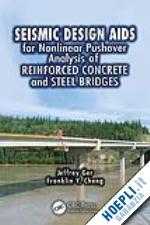Jeffrey Ger, PhD, PE, is the Federal Highway Administration (FHWA) Division Bridge Engineer in Florida, Puerto Rico, and U.S. Virgin Islands. His research experience has been in the field of earthquake engineering, nonlinear structural response, and building and highway bridge design. He has published more than 40 technical papers in structural engineering. Dr. Ger received the U.S. Secretary of Transportation’s Team Award in 2004 "for providing extraordinary transportation services to move food, water and shelter materials to relieve the pain and suffering by millions of victims of the 2004 Hurricanes." He provided critical support in the wake of Florida’s 2004 hurricanes, completing an emergency interstate bridge repair project 26 days ahead of schedule. In 2006, he received the FHWA Bridge Leadership Council’s Excellent Award, recognizing his outstanding customer service in carrying out the bridge program in Florida. He received the FHWA Engineer of the Year Award and an award from the National Society of Professional Engineers in 2007, and in 2008 received the Civil Engineering Academy Award from the Department of Civil Engineering at the University of Missouri-Rolla. Dr. Ger was appointed as one of the seven members of the U.S. Transportation Infrastructure Reconnaissance Team that traveled to Chile in April 2010 to assess the bridge damage condition due to the February 27, 2010, Chile earthquake. Franklin Y. Cheng, PhD, PE, is a distinguished member (formerly honorary) of ASCE; a member of the Academy of Civil Engineers, Missouri University of Science and Technology (MST); and Curators’ Professor Emeritus of Civil Engineering at MST. He is one of the pioneers in allying computing expertise to large, complex, seismic-resistant structures. Dr. Cheng has received four honorary professorships abroad and chaired seven of his 24 National Science Foundation (NSF) delegations to various countries for research and development cooperation. He has served as either chairman or member of 37 professional societies and committees. Dr. Cheng has served as a consultant for Martin Marietta Energy Systems Inc., Los Alamos National Laboratory, and Martin & Huang International, among others. The author, coauthor, or editor of 26 books and over 250 publications, Dr. Cheng is the recipient of numerous honors, including the MSM-UMR Alumni Merit, ASCE State-of-the-Art (twice), the Faculty Excellence, and the Halliburton Excellence awards. In 2007, he was elected as the 565th honorary member of ASCE since 1852. Dr. Cheng has numerous publications to his credit, the most recent being Structural Optimization: Dynamic and Seismic Applications, Smart Structures: Innovative Systems for Seismic Response Control, and Matrix Analysis of Structural Dynamic: Applications and Earthquake Engineering.











